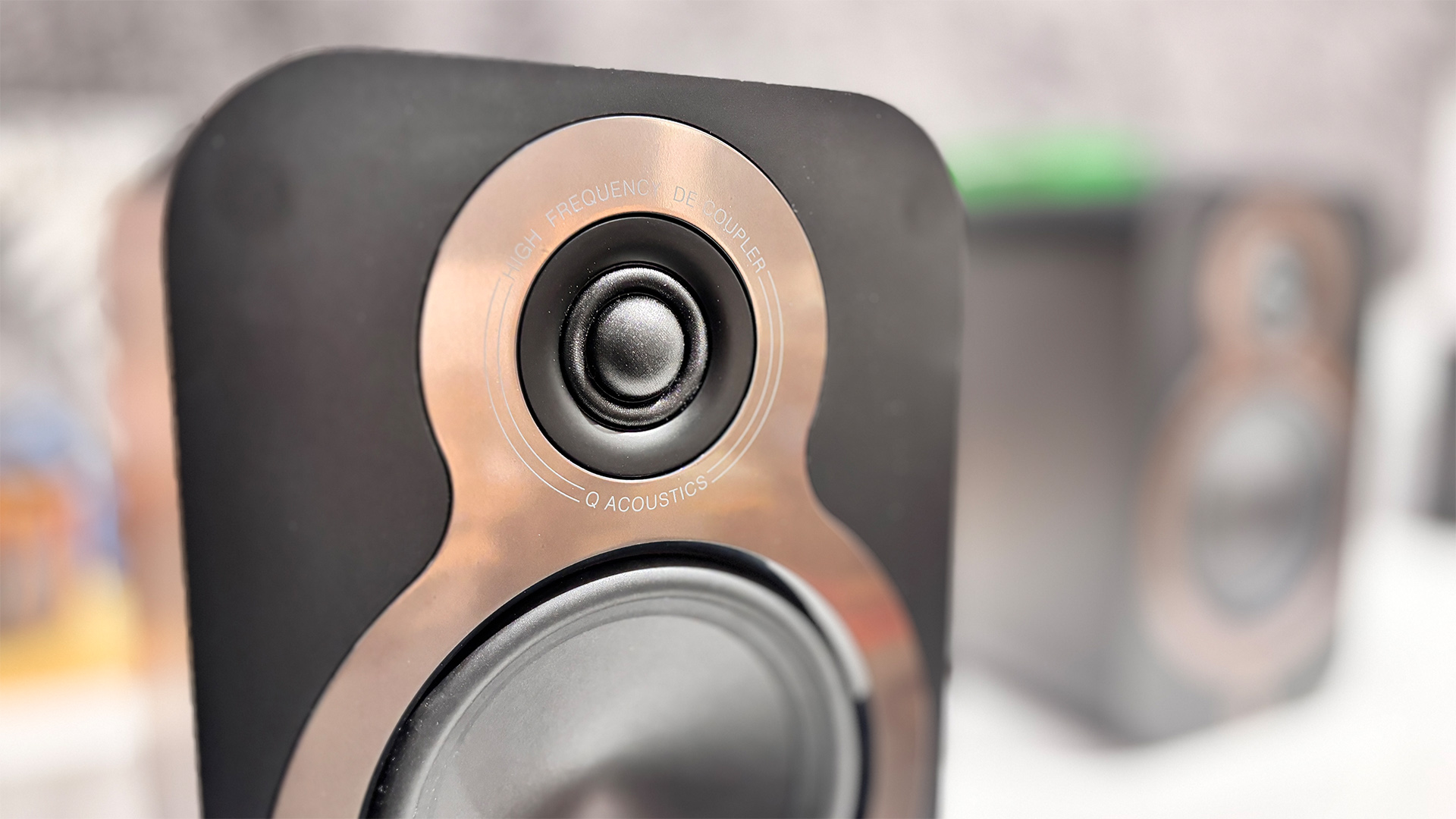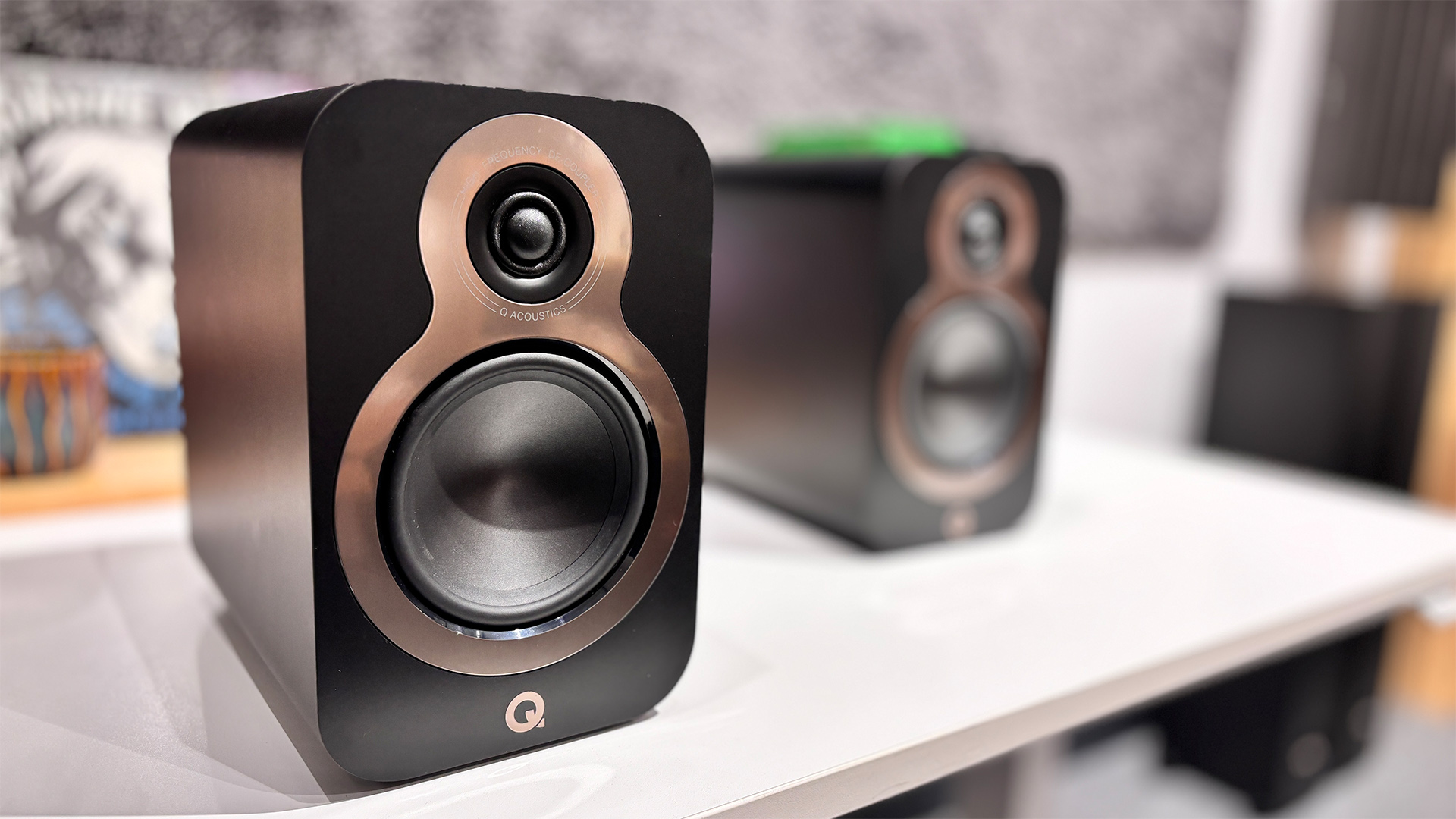What Hi-Fi? Verdict
The 3020c are a satisfying pair of standmounts, delivering a detailed, clear sound with plenty of taut bass. A greater sense of drama wouldn’t hurt, though
Pros
- +
Clear, detailed sound
- +
Controlled, taut bass reproduction
- +
Nicely built and finished
Cons
- -
Class leaders offer a more involving listen
- -
Rhythms could be more fluid
- -
Need real care with partnering
Why you can trust What Hi-Fi?
It’s not hard to see why Q Acoustics' 3000 speaker range has been one of the brand’s most popular. With a focus on as much sound-per-pound performance as possible, it has enticed and delighted rafts of listeners who just want a pair of speakers that will do the job without having to fork out bank-busting sums in the process. In terms of supremely well-valued speakers, the Q Acoustics’ entry-level lines have produced multiple five-star favourites and What Hi-Fi? Award-winning all-stars over the years.
The new Q Acoustics 3000c series was first revealed at this year’s High End Munich showcase and aims to take the range’s talents to new heights, albeit with some inflated price tags to match this bump in performance. This range has been six years in the making, but can the Q Acoustics 3020c standmount speakers continue the legacy of their forebears?
Price

The new 3020c speakers cost £399 / $499 / AU$899, making them one of Q Acoustics' most affordable entry-level options (the cheapest is the 3010c at £299 / $399), following the demise of the older 1000 and 2000 ultra-budget ranges. Those figures might not seem like a lot on paper, but they still represent a substantial price increase over previous generations: the original 3020 cost £190 in 2015, while the 3020i launched at £249 / $249 in 2018.
Of course, factors such as inflation, the rising cost of materials and supply-chain issues have meant that prices in general have increased across hi-fi products in the past few years. This is a common trend with most new products, so it's perhaps not a big surprise that the price of the new 3000c models has also risen in the six years since the last generation.
At this price point, the 3020c face strong competition. The five-star Triangle Borea BR03 and Dali Oberon 1 speakers currently cost around £399 / $500 and £399 / $600 respectively, whereas our 2024 Award-winning Wharfedale Diamond 12.1 are a lot more affordable at £249 / $399 / AU$699.
Build & design

Visually, the 3020c are a pair of Q Acoustics speakers through and through. The British brand has always gone for that unobtrusive, minimalist aesthetic, with that signature snowman-esque driver array complemented by rounded cabinet edges and a modest look that will appeal to anyone who wants a set of speakers that will fit nicely into their surroundings.
We appreciate how nicely the 3020c are made, though, especially that handsome one-piece metallic bezel around the dual drive units and the smooth, polished feel of the cabinets which, if you’re fussy about colour co-ordination, are available in four finishes: black, white, walnut and oak. The rear-ported standmounters aren’t bi-wirable, but their sensitivity of 87dB/W/m and nominal impedance of 6 ohms does make them fairly typical for speakers at this size and price.

Type Standmount
Drive units 22mm tweeter, Continuous Curved Cone 12cm mid/bass
Ported? Yes (rear)
Bi-wire? No
Impedance 6 ohms (nominal)
Sensitivity 87dB
Dimensions (hwd) 27.9 x 17.5 x 28.1cm
Weight (each) 5.5kg
Finishes x 4 (black, white, walnut, oak)
At the heart of the new standmounts is Q Acoustics’ Continuous Curved Cone, the driver technology that the company first introduced in its more premium 5000 series and which is deployed here for the 12cm impregnated paper mid/bass driver. The new design aims to “elevate the 3000c range above its peers” by offering an “articulate and fast mid-range, controlled bass dynamics and detailed high frequencies”. Essentially, it seeks to combine the advantages of a flared cone and a straight-edge arrangement without incurring their respective drawbacks, while a lack of a traditional dust cap means all the distortions that are traditionally associated with such a design are avoided. Such aspects have certainly been successful with the excellent Q Acoustics 5040 and 5050 floorstanders, so we’re hoping that the clarity and expressiveness of those speakers have filtered down to the 3020c.
The 22mm tweeter has been decoupled from the front baffle, helping to isolate it from vibrations generated by the mid/bass driver. It has also been hermetically sealed to protect it from internal pressure changes from the cabinet, resulting in a better, less distorted sound.
Compatibility

Getting the 3020c to really sing takes more work than we had anticipated during our testing period. In terms of sources, most of our testing is done using the Naim Uniti Atom Headphone Edition music streamer and the Cyrus CDi CD player.
Getting the right amplification is trickier, as the naturally lean and forward nature of the 3020c means that they need an amp that will soften their insistent approach. We start off using the clear and expressive Arcam A15 (tested at £1099 / $999) but find that the richer and more price-compatible Arcam A5 (tested at £749 / $699) gives the 3020c an even fuller, smoother and altogether more satisfying balance.
In terms of positioning, we angle the 3020c slightly inwards so that their axis crosses behind our heads. We find that, in our test rooms, placing the speakers around 35cm away from the back wall is optimal for giving a nice balance of stereo imaging and bass authority, although the precise distance might differ depending on your system and the nature of your listening space. The 3020c also need decent stands – we use the excellent Custom Design FS104 Signature to good effect, but Q Acoustics do make dedicated supports if you want a cheaper set.
Sound

If you thought you knew Q Acoustics’ 3000 range, think again. We’ve heaped praise upon this budget line – be it 2015’s original 3020 standmounts or the Award-winning 3020i follow-ups – for having a refined, smooth sound that makes listening to your music such an easy, pleasant experience. Never boring, the previous generations of the 3000 series won many hearts thanks to a canny sonic presentation that was forgiving of modestly talented budget equipment while also having the capacity to excel with more capable systems.
This new generation, however, is a big departure from what came before, offering a balance that mirrors what we’ve heard from recent members of the more premium 5000 series. Like Linkin Park forging ahead with a brand new frontwoman or England preparing for Tuchel-ball after the rollercoaster ride of Southgate at the wheel, the 3020c have ushered in a new era for Q Acoustics’ budget line, and they’ve brought a new sonic outlook to the party.
Different doesn’t have to mean worse. Pairing the 3020c with the Arcam A5 amp reins in their more over-enthusiastic tendencies, and we’re pleased to hear just how much detail the budget standmounts can wring from the music we feed them. The 3020c are excellent at pulling out instrumental textures, ably revealing the strange tones and crisp beats of Massive Attack’s Risingson and the glossy, twinkling piano at the heart of Debussy’s The Girl With The Flaxen Hair. For outright detail and clarity, they outshine previous standmount members of the 3000 series by a considerable margin.
These are assertive and punchy speakers, too. The 3020c have enough life to bring out Bad Religion's 21st Century (Digital Boy) with the appropriate sense of gusto and propulsiveness. That feeling of enthusiasm is aided by the speakers’ impressively taut bass which, while not earth-shakingly powerful, lends tracks a crisp, efficient nature at the lower end. Rarely blobby or amorphous, we’re also impressed with how those foreboding bass tones from Hans Zimmer’s Like A Dog Chasing Cars are distinctly separated rather than flowing into one another in a rumbly, entangled mess.
While we’re keen on how energetic the 3020c are, we can’t help but wish they had a greater sense of fluidity to go with that undeniable enthusiasm. Rhythmic patterns could certainly feel more natural and less mechanical, with tracks such as Björk’s The Dull Flame Of Desire flowing more naturally through the rival Dali Oberon 1.
Dynamically, the 3020c are also beatable, tending to make dynamic contrasts sound frustratingly subdued. Listen to The Dull Flame Of Desire and you’ll hear how these budget standmounts shortchange the listener when it comes to communicating the song’s evocative swings in intensity and shifts in mood. Whether we’re listening to Hans Zimmer or Björk, the Dali Oberon 1 speakers have far more dynamic shading and differentiation, granting a greater sense of drama as a result. Put simply, when played through the 3020c, Björk sounds like she’s rehearsing; with the Dalis, she’s giving it her all on opening night.
Verdict

There is no denying that the Q Acoustics 3020c are capable speakers. Their clarity, agility and punch are impressive, marking not only a significant step up in these respects for the 3000 series but also setting a high bar for price rivals.
Yet in chasing these qualities, they have also sacrificed the easy-going, fuss-free nature of previous generations. This makes them a more demanding proposition, and one that doesn’t quite have the all-round appeal we hoped for.
First reviewed: October 2024
SCORES
- Sound 4
- Build 5
- Compatibility 3
MORE:
Read our review of the Dali Oberon 1
Also consider the Triangle Borea BR03
Read our Wharfedale Diamond 12.1 review
Best speakers: budget to premium models tested by our expert reviewers
What Hi-Fi?, founded in 1976, is the world's leading independent guide to buying and owning hi-fi and home entertainment products. Our comprehensive tests help you buy the very best for your money, with our advice sections giving you step-by-step information on how to get even more from your music and movies. Everything is tested by our dedicated team of in-house reviewers in our custom-built test rooms in London, Reading and Bath. Our coveted five-star rating and Awards are recognised all over the world as the ultimate seal of approval, so you can buy with absolute confidence.
-
Hifiman It does seem as if hifi retailers are chasing a shrinking market. I note the IBIS World report states ‘The market size of the Audio & Video Equipment Retailers industry in the UK has declined 3.6% per year on average between 2018 and 2023.’ This is especially concerning given this includes the covid period when people were in contrast increasing their discretionary spending on many other luxuries like watches and house moves. Perhaps it just reflects fewer under 50s being interested in hifi anymore.Reply
Whatever the cause, the response of more and more companies (including QAcoustics) seems to be to try and wring more from remaining customers or to try to march upmarket with ridiculously expensive items. I cannot help but feel that this is not a sustainable long term strategy and could instead accelerate the decline, leaving the remaining market to innovative entrants like WiiM or alternatively to the likes of PMC’s recent value-for-money approach. -
Integralista Reply
Hi, I have to agree with you. I am still in shock looking on huge price increase. I have owned previous 3020i and they were realy good, connected with small Rega Brio. It seems, QA has tried to recast the sound signature a lot and the job looks like not finished. QA is very serious manufacturer and I hope they will react on this improvement potential, indicated by this test.Hifiman said:It does seem as if hifi retailers are chasing a shrinking market. I note the IBIS World report states ‘The market size of the Audio & Video Equipment Retailers industry in the UK has declined 3.6% per year on average between 2018 and 2023.’ This is especially concerning given this includes the covid period when people were in contrast increasing their discretionary spending on many other luxuries like watches and house moves. Perhaps it just reflects fewer under 50s being interested in hifi anymore.
Whatever the cause, the response of more and more companies (including QAcoustics) seems to be to try and wring more from remaining customers or to try to march upmarket with ridiculously expensive items. I cannot help but feel that this is not a sustainable long term strategy and could instead accelerate the decline, leaving the remaining market to innovative entrants like WiiM or alternatively to the likes of PMC’s recent value-for-money approach.


